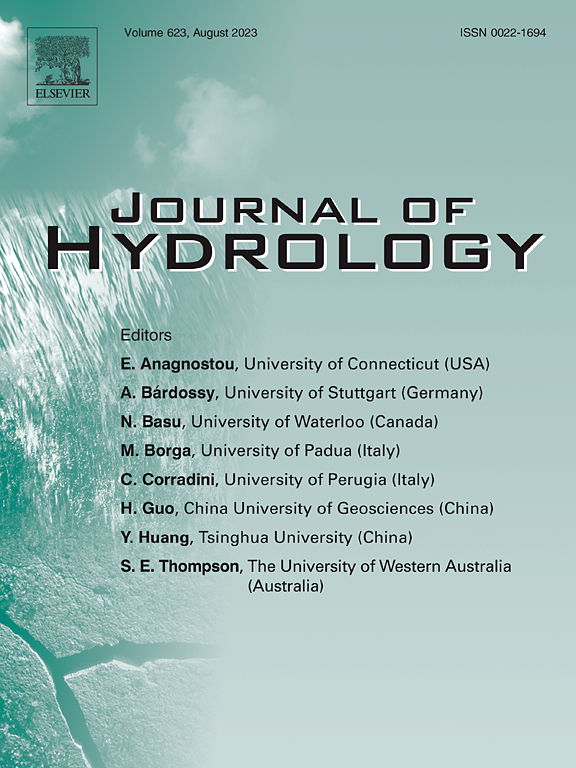Water yield service flow assessment under future SSP-RCP scenarios in the Yellow River Basin: Coupled effect of climate and land use change
IF 6.3
1区 地球科学
Q1 ENGINEERING, CIVIL
引用次数: 0
Abstract
As extreme climate events and human activities increase in frequency, the unreasonable use of water resources and imbalance in supply–demand pose a serious threat to human society. The concept of water yield service flow (WYSF) introduces a new perspective into the research on water supply and demand (WSD) coupling mechanism and water resources management. However, most of the studies on WSD only consider limited factors in their simulation and neglect the supply–demand coupling mechanism, leaving the research from the standpoint of WYSF at a stage that awaits further exploration. This study constructed a coupled analysis framework to examine the impact of Climate and Land Use Change (CLUC) on WSD, aiming to reveal the flow pathways of water under the context of environmental changes in the Yellow River Basin (YRB). On the basis of the supply–demand coupling mechanism, the spatial pathways of WYSF were finally mapped. The results indicated that: (a) The magnitude of climate change is the greatest under the SSP585 scenario, whereas it is more moderate under the SSP126 scenario. (b) Three scenarios exhibit an identical spatial pattern of land use change, which is primarily characterized by the expansion of impervious surface on cultivated land and the encroachment of forest and grassland into water. However, the extent of expansion and reduction varies, with the SSP585 scenario showing the most dramatic change, followed by the SSP126 and SSP245 scenarios. (c) Generally, under the three scenarios, sub-basins with greater supply are located in the upper and lower reaches, whereas areas with greater demand tend to cluster in the northwest and middle and lower reaches. This showed that there is an obvious mismatch in WSD. (d) The analysis of the WYSF networks showed that the introduction of WYSF concept for research can more accurately reflect the spatial match of WSD.
黄河流域未来SSP-RCP情景下产水量服务流量评价:气候与土地利用变化的耦合效应
随着极端气候事件和人类活动频率的增加,水资源的不合理利用和供需失衡对人类社会构成了严重威胁。产水服务流的概念为研究水资源供需耦合机制和水资源管理提供了一个新的视角。然而,大多数关于WSD的研究在模拟中只考虑了有限的因素,忽略了供需耦合机制,从WYSF的角度进行研究还处于一个有待进一步探索的阶段。本研究构建了气候与土地利用变化(CLUC)耦合分析框架,探讨了气候与土地利用变化(CLUC)对黄河流域水资源的影响,旨在揭示环境变化背景下黄河流域水资源的流动路径。在供需耦合机制的基础上,绘制了WYSF的空间路径。结果表明:①SSP585情景下气候变化幅度最大,SSP126情景下气候变化幅度较小;(b) 3种情景均表现出相同的土地利用变化空间格局,其主要特征是耕地上不透水地表的扩大和森林和草地对水的侵蚀。然而,扩展和缩小的程度不同,以SSP585情景变化最明显,其次是SSP126和SSP245情景。(c) 3种情景下,供给量较大的子流域总体分布在上游和下游,而需求量较大的区域则集中在西北部和中下游。这表明水务署存在明显的不匹配。(d)对WYSF网络的分析表明,引入WYSF概念进行研究可以更准确地反映WSD的空间匹配。
本文章由计算机程序翻译,如有差异,请以英文原文为准。
求助全文
约1分钟内获得全文
求助全文
来源期刊

Journal of Hydrology
地学-地球科学综合
CiteScore
11.00
自引率
12.50%
发文量
1309
审稿时长
7.5 months
期刊介绍:
The Journal of Hydrology publishes original research papers and comprehensive reviews in all the subfields of the hydrological sciences including water based management and policy issues that impact on economics and society. These comprise, but are not limited to the physical, chemical, biogeochemical, stochastic and systems aspects of surface and groundwater hydrology, hydrometeorology and hydrogeology. Relevant topics incorporating the insights and methodologies of disciplines such as climatology, water resource systems, hydraulics, agrohydrology, geomorphology, soil science, instrumentation and remote sensing, civil and environmental engineering are included. Social science perspectives on hydrological problems such as resource and ecological economics, environmental sociology, psychology and behavioural science, management and policy analysis are also invited. Multi-and interdisciplinary analyses of hydrological problems are within scope. The science published in the Journal of Hydrology is relevant to catchment scales rather than exclusively to a local scale or site.
 求助内容:
求助内容: 应助结果提醒方式:
应助结果提醒方式:


